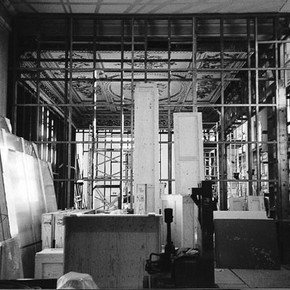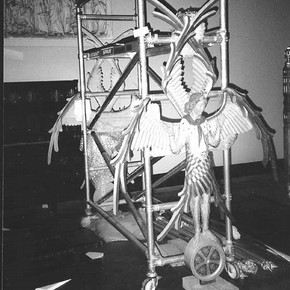Conservation Journal
October 1999 Issue 33
'Method in our Madness': Method Statements and the British Galleries

Figure 1. Dismantling of a period room in the British Galleries. Photo: Julie Taylor (click image for larger version)
This is the story of how the V&A approached the thorny problem of moving a vast number of objects with the relative certainty that they would be handled, packed and transported quickly, safely and economically. Method statements are not a new concept, but this was a new application for the V&A and, if successful, could have interesting implications for our traditional approaches.
British Galleries 1500-1900
The V&A has embarked upon an enormous project: the complete revamping of the British Art and Design Galleries into what will be called British Galleries 1500-1900. The fifteen galleries are being completely transformed with funds from the Heritage Lottery Fund. Where once there were stores and other non-gallery areas, now virtually all of the space will be used for display and these displays will be radically different. But nothing meaningful happens without some sacrifice, so we have had to close and completely clear the galleries in order to carry out essential changes to the fabric of the building.
Every single object within those galleries (and the eight stores they contained) has had to be removed - either to another gallery in the Museum or to our principal storage site. 6000 plus objects, from the very smallest objects the Museum displays, to entire built-in period rooms, have had to be 'decanted.'
The goal
The decant requirement of the V&A was clear and unambiguous: to decant all the objects to their temporary homes with no damage or loss, in the most economical way possible and to schedule. Further, it had to be done without interfering with our visitors' enjoyment of the rest of the Museum, disrupting the Exhibition's schedule and other long-planned projects and the day-to-day running of the Museum.
The problem
In order to execute to above instructions, the decision was made early on to obtain the services of an outside firm to carry out the decant. This was done to free our own Object Handlers (from the Technical Services Department) to take care of the day-to-day operations within the Museum. The firm chosen was Momart Ltd1, whom we had worked with in the past.
The initial hurdle was the traditional procedure for moving objects in the Museum, involving the Object Handlers, the relevant collection, conservation and, if necessary, the Museum Packers. An understanding of what is expected and a sort of shorthand has developed over the many thousands of object-moves to allow us to communicate our concerns and solutions quickly and efficiently. How were we going to develop that kind of understanding with Momart?
Also, procedure dictated that whenever an outside firm moved an object outside the Museum, a condition report must accompany it. This is a detailed document which includes a general description of the condition of the object and photographs of the object with all the previous damage pointed out in various ways, plus notes on handling, display conditions, etc. A conservator would have had to create the report; Momart would then have to agree to the findings. Then, at the end of the move, it would have to be checked for any changes in condition. Multiply that by 6000.
The solution
After some to-ing and fro-ing, a sensible solution began to emerge. Group together objects of similar materials, structure and size, and produce a general statement describing the method for handling, packing, transporting and storing these objects.

Figure 2. One of the 6,000 objects prepared for removal. Photo: Julie Taylor (click image for larger version)
The Conservation Department had already carried out an assessment of the objects' condition to determine their travel-worthiness and estimate how much 'first aid' would be required. These assessments would be used along side the method statements as a brief condition report.
Essentially, these Method Statements would anticipate the potential problems and solve them. Because each stakeholder involved with the object would have a different perspective - Momart would have a certain set of concerns, Conservation another, the British Gallery team and Collections yet another - each would be allowed input. There was overlap, but the statements had to satisfy all those concerned.
Once all parties had had their say and consensus reached on conditions then all involved would sign off on the statements. This was vital, because in the absence of the usual condition report, the contents of the method statement was to be the guarantee of the safety of the object. As long as the method statement was followed, any damage that occurred (other than catastrophic) would be the Museum's responsibility.
Momart was given the task of writing up the Method Statements because they would have to perform the task. The statements were based on extensive discussions carried out on 'walk- throughs' of the galleries with representatives of the British Galleries Team, Momart and relevant Collections and Conservation sections, looking at the objects and talking through how each would be moved.
This process ultimately produced twenty one different Method Statements. This did not include the Period Rooms, which were given separate statements for each room plus a general statement of aims.
To complete the procedure, an Object Dispatch Receipt (ODR) was produced for each object with an attached photograph. The ODR contained all the essential information, including its assessed condition, the appropriate method statement to follow etc. Also included were any special considerations not covered by the method statement that emerged during or after the discussions.
Results
The decant began in October 1998 and was completed to schedule on 21st May 1999. The method statements worked extremely efficiently. Any questions, doubts or clarifications were dealt with on the spot and, if necessary, noted on the ODR.
There was one object damaged by the move and it is unlikely that the situation that caused it could have been anticipated.
The decant could not have been carried out using the traditional procedures the Museum has built up over the years. It needed an innovative solution and willingness on the part of all involved to adopt the innovation quickly and adapt it when necessary. It also meant a shift in approach to the problem of moving an object. The Method Statement forces one to anticipate the problems and solve them before they arise, as opposed to the somewhat reactive Condition Report. It also gives us the ability to go back and sum up how well the statements matched the actual situation by checking the additional comments on the ODRs. We can then adjust the Method Statements appropriately. This is fortunate, because it will soon be time to bring the objects back. The British Galleries 1500-1900 are due to open in December 2001.
References
October 1999 Issue 33
- Editorial - Changing Landscapes
- The British Galleries 1500-1900: An Overview
- 'Method in our Madness': Method Statements and the British Galleries
- Removal and Installation of Mirrors for the British Galleries Project
- The Remounting of a Victorian Tile Panel
- A Brief History of Mounts
- Don't Sit Down! The Investigation and Conservation of an Upholstered Seventeenth Century Settee
- Off-site Radio Telemetry
- Science Surgery
- Printer Friendly Version